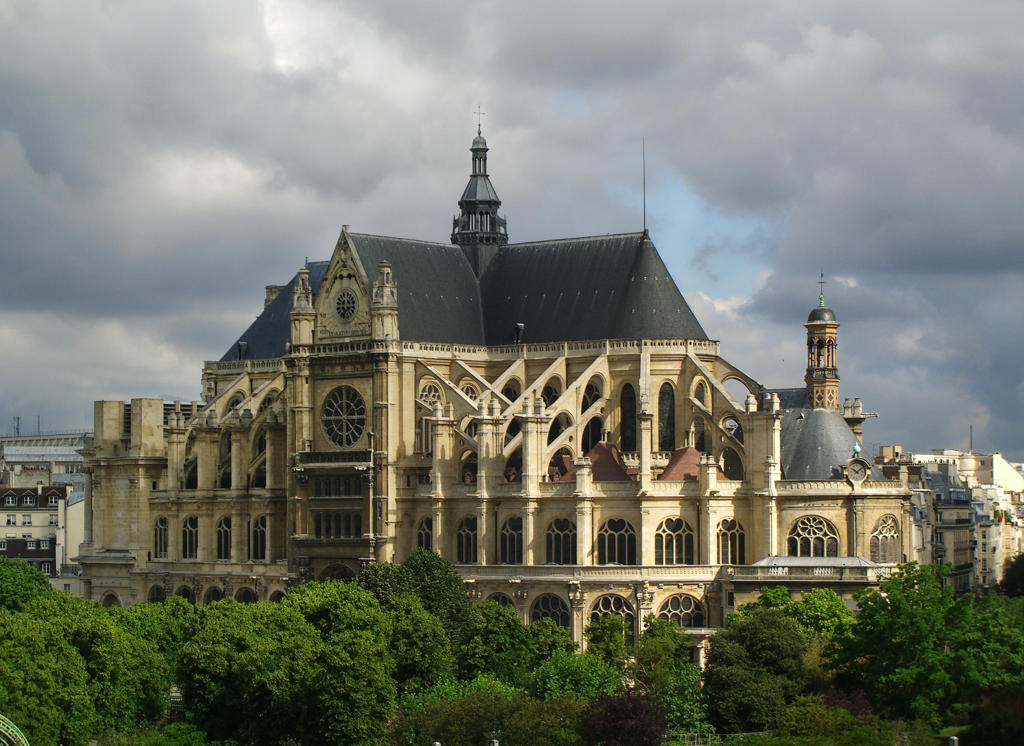About Église Saint-Eustache
This Gothic masterpiece from 1532, the Église Saint-Eustache, stands as a testament to the architectural grandeur of the Renaissance period. Its towering façade, adorned with intricate stone carvings, draws the eye upward to the ornate rose window, a hallmark of Gothic design. The church’s blend of Gothic and Renaissance elements is evident in its flying buttresses and the classical columns that frame its entrance. Inside, the vast nave stretches out, flanked by soaring arches and illuminated by the soft glow of stained glass, creating an atmosphere of reverence and awe.
Located in the historic Les Halles district, the church has been a silent witness to the evolution of Paris from a medieval city to a modern metropolis. Its construction began in the early 16th century and took over a century to complete, reflecting the changing architectural styles and the tumultuous history of France. The church has hosted numerous significant events, including the baptism of Cardinal Richelieu and the funeral of Mozart’s mother, anchoring it firmly in the cultural and historical tapestry of Paris.
Right Where It Began
The site of Église Saint-Eustache has been a place of worship since the 13th century, originally home to a chapel dedicated to Saint Agnes. As Paris grew, so did the need for a larger church, leading to the construction of the current building. The church’s location near the bustling market of Les Halles made it a central part of community life, serving as a spiritual haven amidst the commercial activity. Today, it stands as a reminder of the city’s medieval roots, its stones echoing the prayers and hopes of generations past.
Plan your perfect trip to Paris with Travo! Download now and start exploring.
Marks of Time
The exterior of Saint-Eustache bears the marks of time, with its weathered stone and the patina of age adding to its character. The church’s architecture is a blend of styles, with Gothic elements like pointed arches and ribbed vaults coexisting with Renaissance features such as classical columns and pilasters. This fusion reflects the transitional period in which it was built, capturing the evolution of architectural thought from the medieval to the modern. The church’s bell tower, though never completed, adds to its unique silhouette against the Parisian skyline.
Stories in Stone
The intricate stone carvings on the façade tell stories of faith and devotion, with scenes from the Bible depicted in exquisite detail. The tympanum above the main entrance portrays the Last Judgment, a common theme in Gothic art, inviting visitors to reflect on the eternal themes of salvation and redemption. Inside, the chapels are adorned with sculptures and paintings that narrate the lives of saints and martyrs, each piece a testament to the skill and devotion of the artists who created them.
Details That Speak
Notice the organ, one of the largest in France, with its 8,000 pipes filling the church with a rich, resonant sound. This magnificent instrument has been played by some of the greatest organists in history, including Hector Berlioz and Franz Liszt, and continues to be a focal point of the church’s musical life. The stained glass windows, with their vibrant colors and intricate designs, depict scenes from the life of Christ and the saints, casting a kaleidoscope of light across the stone floors and inviting contemplation and prayer.
Living History
Today, Église Saint-Eustache remains an active place of worship and a cultural landmark. It hosts regular services, concerts, and community events, drawing visitors from around the world who come to admire its beauty and experience its serene atmosphere. The church’s role as a center of spiritual and cultural life in Paris continues, bridging the past and present and offering a space for reflection and inspiration in the heart of the bustling city.

Map loading...
Location
Rue de Turbigo, 75001, Paris
